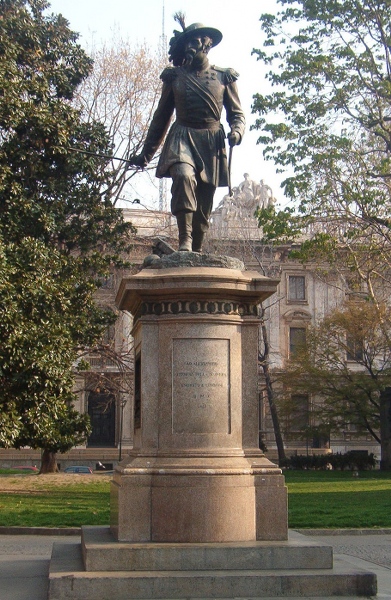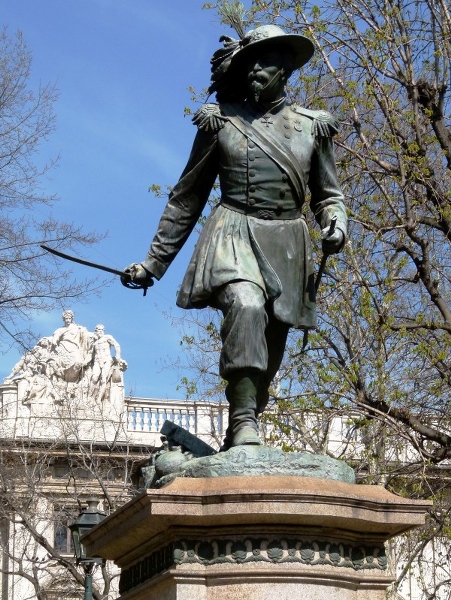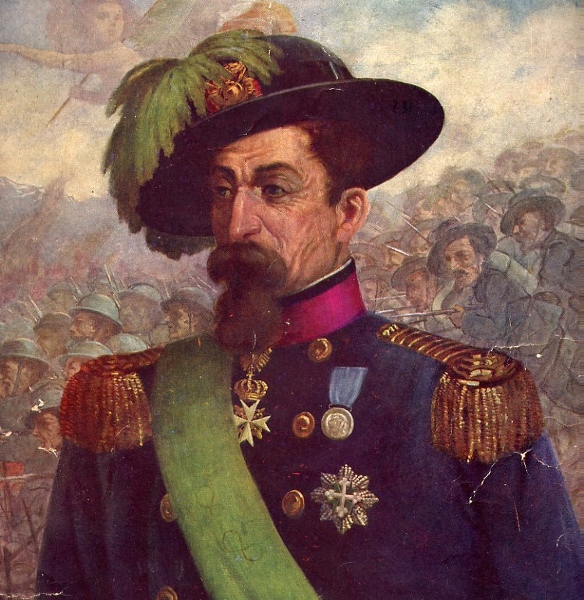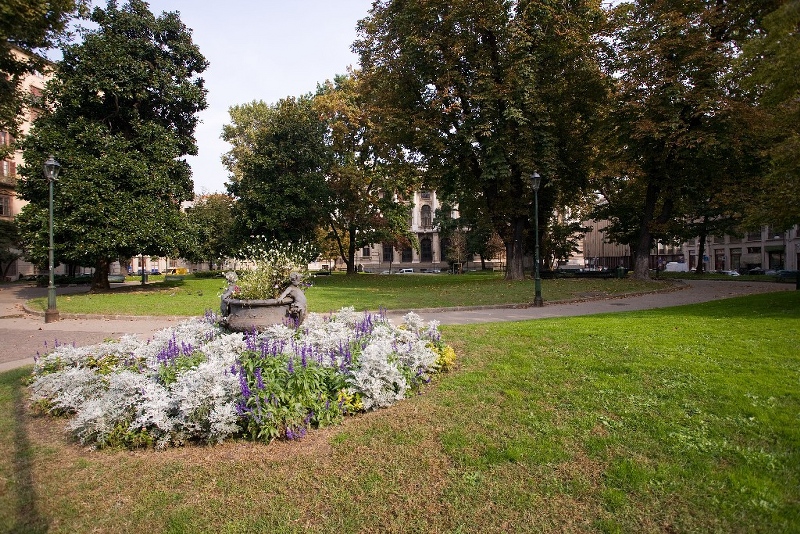The garden of La Marmora
The garden of La Marmora, where the monument of Alessandro La Marmora is located, is on Via Cernia. It is surrounded by Via San Dalmazzo, Via Antonio Guiseppe Bertola and Via Stampatori.

Turin is a city rich in terms of squares which were carefully designed mostly in the nineteenth century when a vast work of embellishment began in the city. To that end, Jean-Charles Adolphe Alphand (1817-1891) and the landscape gardener Jean-Pierre Barillet Deschamps (1824-1873) were invited from Paris. It was Jean-Pierre Barillet Deschamps who designed this garden, like many others that remained almost unchanged.
The public garden of Marmora was built in 1863, based on a drawing by Barillet Deschamps, as part of the urban planning of the new district. In addition to the flowers on the ground, western plane trees, a beech, a red oak, several magnolias, some chestnut trees, liquidambars and ginkos adorn this beautiful garden.
Walking through the alleys or sitting on one of the benches in the garden, one feels watched over by the vigorous gaze of General Alessandro La Marmora, suspended in a fighting attitude in his statue.


Alessandro Ferrero della Marmora (or Alessandro della Marmora or Alessandro La Marmora) ( March 27, 1799 - June 7, 1855) was an Italian general and Patriot.
A great figure in the Italian Risorgimento, he inspired the creation of the Bersaglieri Corps (Light infantry soldiers of the Sardinian army). But this project was carried out 5 years later, in 1835.
During his convalescence for the serious facial injuries suffered at the Battle of Goito in 1848, La Marmora wrote the “Provisional Instructions for the Bersaglieri” and a Shooting Treaty for the use of volunteers. In Genoa, where he was recovering from a horse fall, he met Rosa Roccatagliata in 1852, whom he married two years later.
In the autumn of 1854, a cholera epidemic broke out in the Ligurian capital and Alessandro La Marmora devoted himself to assisting hospitals; he also wrote a pamphlet on the disease, entitled Morbus Cholera.
Despite his weakened physical condition, on March 22, 1855, encouraged by his brother Alfonso, who was five years younger than him, general Alessandro La Marmora took command of the Second Division of the Crimean corps. This was his last expedition.

Like many Bersaglieri, he died of cholera on June 7, 1855, at the age of 56, in Crimea, where he had landed in Balaklava, the current district of Sevastopol, as the head of his Division. His dead body had remained in the Crimea for a long time and in 1911 it was transported to the family crypt of the Basilica of San Sebastiano in Biella.
In the garden of the La Marmora you can also see the monument of the centenary of the body of the bersaglieri, surrounded by magnificent Japanese maples.
This monument dedicated to the centenary of the institution of Bersaglieri, was created by Giorgio Ceragioli (1861-1947) and placed in the gardens of La Marmora in 1936. In the high relief, the winged allegory of the Fatherland flies victoriously over a crowd of Bersaglieri during the attack.


Turin is a city rich in terms of squares which were carefully designed mostly in the nineteenth century when a vast work of embellishment began in the city. To that end, Jean-Charles Adolphe Alphand (1817-1891) and the landscape gardener Jean-Pierre Barillet Deschamps (1824-1873) were invited from Paris. It was Jean-Pierre Barillet Deschamps who designed this garden, like many others that remained almost unchanged.
The public garden of Marmora was built in 1863, based on a drawing by Barillet Deschamps, as part of the urban planning of the new district. In addition to the flowers on the ground, western plane trees, a beech, a red oak, several magnolias, some chestnut trees, liquidambars and ginkos adorn this beautiful garden.
Walking through the alleys or sitting on one of the benches in the garden, one feels watched over by the vigorous gaze of General Alessandro La Marmora, suspended in a fighting attitude in his statue.


Alessandro Ferrero della Marmora (or Alessandro della Marmora or Alessandro La Marmora) ( March 27, 1799 - June 7, 1855) was an Italian general and Patriot.
A great figure in the Italian Risorgimento, he inspired the creation of the Bersaglieri Corps (Light infantry soldiers of the Sardinian army). But this project was carried out 5 years later, in 1835.
During his convalescence for the serious facial injuries suffered at the Battle of Goito in 1848, La Marmora wrote the “Provisional Instructions for the Bersaglieri” and a Shooting Treaty for the use of volunteers. In Genoa, where he was recovering from a horse fall, he met Rosa Roccatagliata in 1852, whom he married two years later.
In the autumn of 1854, a cholera epidemic broke out in the Ligurian capital and Alessandro La Marmora devoted himself to assisting hospitals; he also wrote a pamphlet on the disease, entitled Morbus Cholera.
Despite his weakened physical condition, on March 22, 1855, encouraged by his brother Alfonso, who was five years younger than him, general Alessandro La Marmora took command of the Second Division of the Crimean corps. This was his last expedition.

Alessandro La Marmora
Like many Bersaglieri, he died of cholera on June 7, 1855, at the age of 56, in Crimea, where he had landed in Balaklava, the current district of Sevastopol, as the head of his Division. His dead body had remained in the Crimea for a long time and in 1911 it was transported to the family crypt of the Basilica of San Sebastiano in Biella.
In the garden of the La Marmora you can also see the monument of the centenary of the body of the bersaglieri, surrounded by magnificent Japanese maples.
This monument dedicated to the centenary of the institution of Bersaglieri, was created by Giorgio Ceragioli (1861-1947) and placed in the gardens of La Marmora in 1936. In the high relief, the winged allegory of the Fatherland flies victoriously over a crowd of Bersaglieri during the attack.

Address:
Chernaya street, Turin
